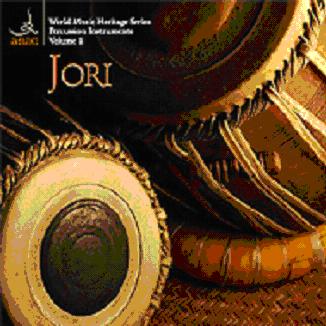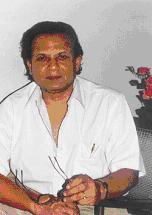Contribute
| Music Review - Jori |
Reviewed by Bharat Gupt
09/08/2005
(This article is sponsored by Sounds Of India)
JORI : Percussion Instruments Vol I CD audio player Bhai Baldeep Singh Anad Records Pvt Ltd.
The digital revolution provided an unprecedented opportunity for the young artists to publish their own music without the patronage of well-known record companies. This can some times bring to the fore some rare areas of expertise which commercial operators normally ignore.
This audio CD is one such rare treat where which the listener gets to enjoy the percussion art of a special kind on an instrument that is not so much in vogue. The Jori, developed in the medieval times is said to be brought to the fore by the Sikh guru Sri Arjun Dev ji, by splitting the age-old instrument called the pakhawaj into two. Although instrument like this pair can be seen in ancient sculptural art, the Jori developed the repertoire of its contemporary pakhawaj into a vigorous style. The two parts called dhamma (left) and puda (right) are kept vertically on the floor, the first of 14 inches and as heavy as 16 kilogram and the second a few inches smaller. The left one produced deeper base sounds that are strong, expansive and resonating, unequaled by any other Indian drum. The right one again being upright allows greater modulation of strokes as well as volume. The Jori thus catered to the temperament of vigorous music of dhruvapad as distinct from the mannerisms of softness highlighted in the khayal of the much later period.
Three major sites of Indian performing arts, namely temples, courtesan houses and theatres were nearly wiped out particularly in the North, by the Islamic ravages and its shariat code. By the end of the twelfth-century, ashrams and the courts (that mostly defied the maulawis) were left as the only seats of dance and music. As the forums of secular music especially theatre declined, performance being ashram centric tended to concentrate on spiritual and philosophic themes under the impact of bhakti or devotional other worldliness. The royal courts merely patronized the music created in religious circles like ashrams and sufi khankahs. This narrowed but concentrated urge created a massive variety of devotional music in medieval India of which the brijbhasha dhruvapad patronized initially by Man Singh Tomar of Gwalior (1486-1514) was dominant form in the North. ‘Raagdarpana’ (1662, a translation by Fakirullah of ‘Maankutuhala’ composed by Man Singh and his pandits, even calls him the inventor of dhruvapada).
The songs of all sects of Indian spiritual pursuits were sung in the dhruvapada style. Guru Nanak (1469-1539) and his successors till Guru Arjan Dev (1563-1609) who installed the Adi Granth at Amritsar at the holy shrine of Durbar Sahib in 1604, undoubtedly must have sung their compositions in the dhruvapada style. The Jori, along with the mridang or pakhavaj, thus is the primary drum of the Gurbani kirtan which was performed according to the highest standards of what is now called classical music.
As a percussion instrument the Jori incorporated all the features of the sophisticated and complex rhythmic work that came to be developed in the course of the centuries that unfolded. It seems to have taken many contributions from various parts of the country to develop a comprehensive repertoire of what came to be known as the Amritsari baaj and which included elements like saath, jat, and the latest called the gat which was adapted by tabla playing.
The Gurbani kirtan from its very outset preserved the purely devotional ambience of that dominated in the dhruvapad songs and pakhawaj and jori rhythms, and which in the royal courts softened into excessive embellishments and heavy ornamentations that eventually declined into the decorative and sentimental khayal singing with tabla accompaniment. The Gurbani kirtan which had preserved till very recently the dhruvapad style has yielded now to the demands of popularity and diluted the tradition with music of the lighter vein.
The player in this CD, is Bhai Baldeep Singh who inherits the Gurbani tradition by training under his grand uncles who are the 11th generation singers of the holy text, and who has also learnt from some the most eminent exponents of the dhruvapad. For the Jori, he learnt from like Bhai Arjan singh Tarangar and many other artists of eminence. His site can be visited at: www.bhaibaldeepsingh.com and that of the publisher at www.anadrecords.com
The three track CD which contains (i) Chautal (cheda and mukaa) in vilambit laya, (ii) Chautal (dugan, pakki dugan, paudi, rela and mukaa) and (iii) Chautal (tigan, pakki tigan, various aad, padaal, savai dugan paudi, paran, rela and mukah) is a most invigorating listening experience. The clarity of the bols (strokes), volume modulation, and the complicated rhythmic cycles all reflect the Amritsari baaj as well as the innovation capacity of the player. The combined modulation of the left and the right of the Jori has been impressively achieved. Though the present CD is restricted to one taal namely the Chautaal, obviously in order to show all the variety and detail of execution, it is hoped that Bhai Baldeep Sigh will display his skills again I similar detail in other taals in the successive disks.
Baldeep’s production will also help to dispel the false notion that dhruvapad and pakhawaj were largely practiced in Central India and that the present day gharanaas (stylistic schools taking their names from the kingdoms) around Delhi, Rampur, Lucknow, Benaras and Patna are the true and only inheritors of the Mughal court music. The devotional music of Gurbani seems to have encouraged and patronized great artists just as the temples and ashrams through out India were doing.
It is also to be noted that the lehra or the rhythmic cycle is provided not on the harmonium (as in the present practice) but on the rabab which was the main string instrument that was used for Gurbani from the time of Guru Nanak himself.
Undoubtedly this sterling effort is a good sign towards the revival of the deeper spiritual aspect of Sikh tradition which in the recent decades has been looked upon (particularly by the ‘global’ and ‘mainstream’ scholars) largely as a politico/ethnic entity.
You may also access this article through our web-site http://www.lokvani.com/


Bharat Gupt
